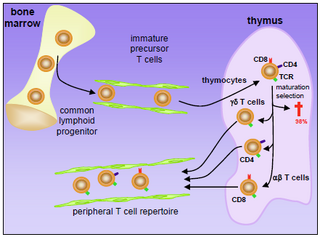|
|
| Untersuchte Arbeit: Seite: 26, Zeilen: 5-19 |
Quelle: Skapenko et al 2005 Seite(n): S5, Zeilen: figure |
|---|---|

Figure 5: Schematic representation of T cell development. T cells originate from the common lymphoid progenitor cells in the bone marrow. They migrate as immature precursor T cells via bloodstream into thymus, which they populate as thymocytes. The thymocytes go through a series of maturation steps including distinct changes in the expression of cell surface receptors, such as the CD3 signalling complex (not shown) and the coreceptors CD4 and CD8, as well as the arrangement of their antigen receptor (T cell receptor, TCR) genes. More than 98% of the thymocytes die during maturation by apoptosis (†), as they undergo positive selection for their TCR´s compatibility with self-major histocompatibility molecules, and negative selection against those T cells that express TCRs reactive to autoantigenic peptides. In humans, the vast majority of peripheral blood T cells express TCRs consisting of α and β chains (αβ T cells). A small group of peripheral T cells bear an alternative TCR composed of γ and δ chains (γδ T cells). αβ and γδ T cells diverge early in T cell development. Whereas αβ T cells are responsible for the classical helper or cytotoxic T cell response, the function of the γδ T cells within the immune system is largely unknown. αβ T cells that survive thymic selection lose expression of either CD4 or CD8, increase the level of expression of the TCR, and leave the thymus to form the peripheral T cell repertoire (adapted from Skapenko et al., 2005). Skapenko A, Leipe J, Lipsky PE, Schulze-Koops H. The role of the T cell in autoimmune inflammation. Arthritis Res Ther. 2005; 7 Suppl 2: S4-14. Epub 2005 Mar 16. |

Schematic representation of T cell development. T cells originate from the common lymphoid progenitor cells in the bone marrow. They migrate as immature precursor T cells via the bloodstream into the thymus, which they populate as thymocytes. The thymocytes go through a series of maturation steps including distinct changes in the expression of cell surface receptors, such as the CD3 signaling complex (not shown) and the coreceptors CD4 and CD8, and the rearrangement of their antigen receptor (T cell receptor, TCR) genes. More than 98% of the thymocytes die during maturation by apoptosis (†), as they undergo positive selection for their TCR's compatibility with self-major histocompatibility molecules, and negative selection against those T cells that express TCRs reactive to autoantigenic peptides. In humans, the vast majority of peripheral blood T cells expresses TCRs consisting of α and β chains (αβ T cells). A small group of peripheral T cells bears an alternative TCR composed of γ and δ chains (γ/δ T cells). αβ and γδ T cells diverge early in T cell development. Whereas αβ T cells are responsible for the classical helper or cytotoxic T cell responses, the function of the γδ T cells within the immune system is largely unknown. αβ T cells that survive thymic selection lose expression of either CD4 or CD8, increase the level of expression of the TCR, and leave the thymus to form the peripheral T cell repertoire. |
The source is given, but it is not clear to the reader that the very extensive caption is taken from it more or less literally. |
|